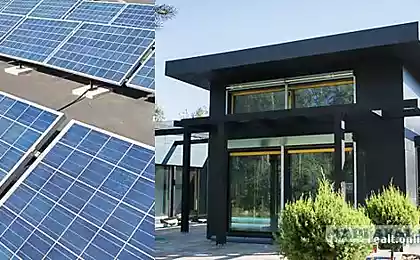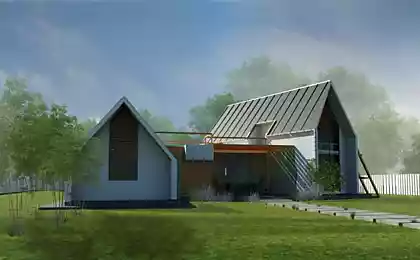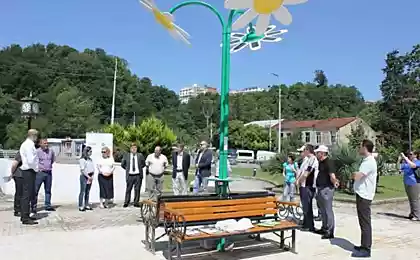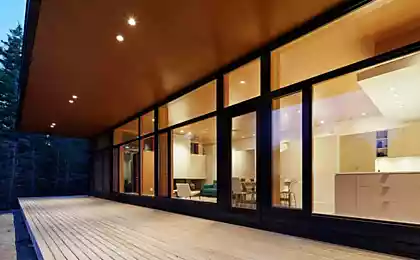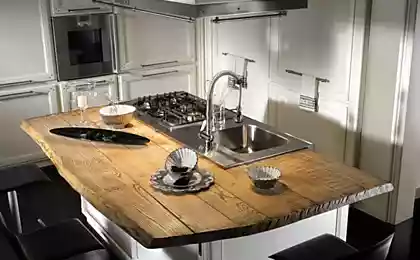575
Energy efficient house with his own hands
Russia is a country with a cold climate, where the average duration of the heating season is seven months. And due to the constant rise in energy prices, the construction of houses with low power consumption becomes more relevant than ever.
Every day more and more people think about the use of energy efficient technologies. This is not surprising because each of us wants to live in a warm and most importantly – economical house.
1. Energy efficient home is...

What we mean by the phrase – energy-efficient house?
According to the head of the company Tkdom Alexander Vodovozova, an energy efficient home is the building, which minimized all of the energy loss and energy consumption. The basic principle of construction of energy efficient house is to achieve maximum tightness of the home, using energy-saving technologies and elimination of cold bridges.
In Russia, the main energy need for heating, so the main task is prevention of heat loss through the building envelope of the building – floors, walls, Windows, floors and roof. This can be achieved with the help of modern technologies of frame construction. Through the use of heaters and special ways of covering the frame, completely eliminates the presence of cracks.
Thus, for the construction of energy-efficient homes should:
To build insulated foundations. In frame construction, this Foundation still plays a role and the heat accumulator;
To install high efficiency ventilation system with heat recovery. Since the vents lost 30-40% of heat, the use of this system will significantly reduce energy consumption for heating the supply air;
Positioning the living room in the southern part of the building. That will allow you to use solar energy as a supplemental source of heat;
To produce the maximum warming of protecting designs. It is through them the main heat loss.
But often, developers simply do not want to invest in additional insulation in the belief that it will increase the cost of the building. So is it profitable to build energy efficient house?
If you speak the language of numbers, the construction of energy-efficient homes cost about 15% more expensive than usual, but it is cheaper by 60-70%.
We can say that the construction of energy efficient house is a complex event that allows you to save your money in the foreseeable future.
2.The Foundation of the "Insulated Swedish Plate" — as the basis for energy-efficient home
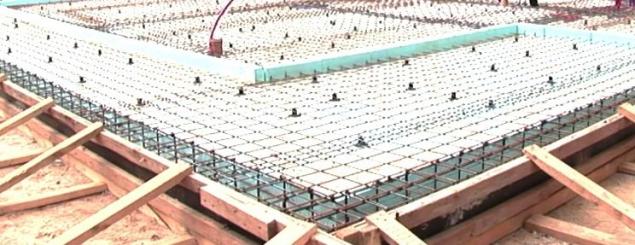
There is a perception that additional insulation of the Foundation a waste of money. But is it really?
Thermal energy losses occur constantly, and differ only in intensity depending on the type of design. For example, the highest heat flux passes through the upper roof structure that is related to the density of warm and cold air. Warm air tends to rise up, together with the pulling power and heat. Also occurs and a large heat loss through the Foundation.
All heat loss can be divided into heat losses that can be prevented and those that lend themselves to a slight reduction! For example, heat loss through the Foundation at an average of 10-15% of total heat loss of the building. Therefore, the construction of energy efficient houses should start with the construction of insulated Foundation.
One of the most effective ways to reduce energy consumption for heating buildings is to build a house on a Foundation of type "Insulated Swedish Plate". For this purpose, it uses extruded polystyrene.When choosing a heater it is necessary to pay attention to the rate of heat conduction. The smaller the better because you will need a smaller thickness of the layer of insulation.
The device is energy-efficient slab foundations should also remember about such an important indicator as to the strength of the insulation in compression. Since these foundations are insulated from below, the insulation should withstand the weight of the whole house, with all the variable loads!
3.The selection of the optimum thickness of insulation
Through wall loss of up to 20-30% of the heat. What thickness of insulation should be chosen for the construction of energy-efficient home?
First, the thickness of the layer of insulation depends on the building structure. If frame technology, for the Central region of Russia, recommended standards of insulation thickness is 150 mm, and optimal from the point of view of efficiency the thickness is 250-300 mm, in the construction of houses of foam concrete, the effective thickness is estimated to be 150-200 mm, while the standard 80 mm. For the roof you should use at least 250-300 mm of insulation. In addition to the optimum thickness, when selecting insulation it is necessary to consider that the thermal insulation is produced in various grades for use in various building structures, where each product solves a specific task and complies with the relevant requirements.
The construction of energy-efficient home involves a balance between cost of materials and high-quality thermal insulation of walls and roof. Therefore, there is no need to increase the insulation layer is more than 30% of the recommended values. Otherwise, increasing estimates, and the project becomes unprofitable.
4. The thicker the wall the warmer the house?
Implying the energy efficiency of private homes need to think not only about the reduction of domestic energy consumption, but also on additional ways to accumulate heat, which will reduce heating costs. There is a misconception that the thicker walls of a house under construction, so it will be warmer, but is it really?
There are principles and technologies that must be used when design and construction. And energy efficiency home in the first place will depend on the thickness of the underlying insulation.
So what principles and technologies still need to be guided in the construction of energy-efficient home?
First the developer must understand that the basic principle of building an energy efficient home is to save thermal energy. Modern technologies allow to reduce the heat loss of the house, until the internal radiation from people and appliances.Neskollko things with electricity and hot water. Their consumption usually greatly reduce cannot, because they depend mainly on the habits of the owners and directly affect the comfort of living.
The potential customer must first order the project is a serious project organization, with experience in designing energy efficient homes;
Still in the design phase, you must include in house design of modern types of insulation. We lay high value of heat transfer resistance;
As Windows loses about 15-25% of the heat, it is necessary to use glazing with glass panes of three Windows with an argon fill.
Author: Rinat Dustabanov
Source: www.newshouse.ru/page-id-5120.html
Every day more and more people think about the use of energy efficient technologies. This is not surprising because each of us wants to live in a warm and most importantly – economical house.
1. Energy efficient home is...

What we mean by the phrase – energy-efficient house?
According to the head of the company Tkdom Alexander Vodovozova, an energy efficient home is the building, which minimized all of the energy loss and energy consumption. The basic principle of construction of energy efficient house is to achieve maximum tightness of the home, using energy-saving technologies and elimination of cold bridges.
In Russia, the main energy need for heating, so the main task is prevention of heat loss through the building envelope of the building – floors, walls, Windows, floors and roof. This can be achieved with the help of modern technologies of frame construction. Through the use of heaters and special ways of covering the frame, completely eliminates the presence of cracks.
Thus, for the construction of energy-efficient homes should:
To build insulated foundations. In frame construction, this Foundation still plays a role and the heat accumulator;
To install high efficiency ventilation system with heat recovery. Since the vents lost 30-40% of heat, the use of this system will significantly reduce energy consumption for heating the supply air;
Positioning the living room in the southern part of the building. That will allow you to use solar energy as a supplemental source of heat;
To produce the maximum warming of protecting designs. It is through them the main heat loss.
But often, developers simply do not want to invest in additional insulation in the belief that it will increase the cost of the building. So is it profitable to build energy efficient house?
If you speak the language of numbers, the construction of energy-efficient homes cost about 15% more expensive than usual, but it is cheaper by 60-70%.
We can say that the construction of energy efficient house is a complex event that allows you to save your money in the foreseeable future.
2.The Foundation of the "Insulated Swedish Plate" — as the basis for energy-efficient home

There is a perception that additional insulation of the Foundation a waste of money. But is it really?
Thermal energy losses occur constantly, and differ only in intensity depending on the type of design. For example, the highest heat flux passes through the upper roof structure that is related to the density of warm and cold air. Warm air tends to rise up, together with the pulling power and heat. Also occurs and a large heat loss through the Foundation.
All heat loss can be divided into heat losses that can be prevented and those that lend themselves to a slight reduction! For example, heat loss through the Foundation at an average of 10-15% of total heat loss of the building. Therefore, the construction of energy efficient houses should start with the construction of insulated Foundation.
One of the most effective ways to reduce energy consumption for heating buildings is to build a house on a Foundation of type "Insulated Swedish Plate". For this purpose, it uses extruded polystyrene.When choosing a heater it is necessary to pay attention to the rate of heat conduction. The smaller the better because you will need a smaller thickness of the layer of insulation.
The device is energy-efficient slab foundations should also remember about such an important indicator as to the strength of the insulation in compression. Since these foundations are insulated from below, the insulation should withstand the weight of the whole house, with all the variable loads!
3.The selection of the optimum thickness of insulation
Through wall loss of up to 20-30% of the heat. What thickness of insulation should be chosen for the construction of energy-efficient home?
First, the thickness of the layer of insulation depends on the building structure. If frame technology, for the Central region of Russia, recommended standards of insulation thickness is 150 mm, and optimal from the point of view of efficiency the thickness is 250-300 mm, in the construction of houses of foam concrete, the effective thickness is estimated to be 150-200 mm, while the standard 80 mm. For the roof you should use at least 250-300 mm of insulation. In addition to the optimum thickness, when selecting insulation it is necessary to consider that the thermal insulation is produced in various grades for use in various building structures, where each product solves a specific task and complies with the relevant requirements.
The construction of energy-efficient home involves a balance between cost of materials and high-quality thermal insulation of walls and roof. Therefore, there is no need to increase the insulation layer is more than 30% of the recommended values. Otherwise, increasing estimates, and the project becomes unprofitable.
4. The thicker the wall the warmer the house?
Implying the energy efficiency of private homes need to think not only about the reduction of domestic energy consumption, but also on additional ways to accumulate heat, which will reduce heating costs. There is a misconception that the thicker walls of a house under construction, so it will be warmer, but is it really?
There are principles and technologies that must be used when design and construction. And energy efficiency home in the first place will depend on the thickness of the underlying insulation.
So what principles and technologies still need to be guided in the construction of energy-efficient home?
First the developer must understand that the basic principle of building an energy efficient home is to save thermal energy. Modern technologies allow to reduce the heat loss of the house, until the internal radiation from people and appliances.Neskollko things with electricity and hot water. Their consumption usually greatly reduce cannot, because they depend mainly on the habits of the owners and directly affect the comfort of living.
The potential customer must first order the project is a serious project organization, with experience in designing energy efficient homes;
Still in the design phase, you must include in house design of modern types of insulation. We lay high value of heat transfer resistance;
As Windows loses about 15-25% of the heat, it is necessary to use glazing with glass panes of three Windows with an argon fill.
Author: Rinat Dustabanov
Source: www.newshouse.ru/page-id-5120.html

